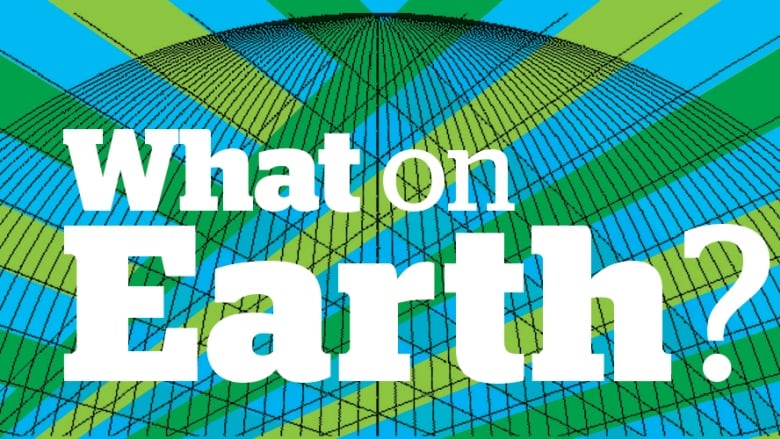Also: A new way to think about wildlife protection

Our planet is changing. So is our journalism. This weekly newsletter is part of a CBC News initiative entitled "Our Changing Planet" to show and explain the effects of climate change. Keep up with the latest news on our Climate and Environment page.
Sign up here to get this newsletter in your inbox every Thursday.
This week:
- What you won't learn about in Oppenheimer: the potential effects of a nuclear winter
- A new way to look at wildlife protection
- B.C. big tree hunter documents grandest old-growth tree he's ever seen
What you won't learn about in Oppenheimer: the potential effects of a nuclear winter

The movie Oppenheimer, which is approaching half a billion dollars at the global box office, has renewed interest in the history of the atomic bomb.
The Trinity test, which was the first atomic bomb exploded and the centrepiece of Christopher Nolan's film, took place more than 78 years ago. But the possibility of nuclear warfare remains to this day. For example, earlier this week, former Russian prime minister Dmitry Medvedev threatened the use of nuclear weapons if Ukraine's current counteroffensive threatens Russian territory.
One potential effect of the atom bomb wasn't understood until years after the death of J. Robert Oppenheimer, the director of the Manhattan Project. Specifically, the concept of nuclear winter, which was first brought to the world's attention by astrophysicist and author Carl Sagan in 1983.
Virtually every modern climate model has confirmed the initial findings: nuclear war would cool the planet.
"Nuclear weapons dropped on cities and industrial areas would produce fires, the fires would produce smoke, and that smoke would be lofted up into the stratosphere in a giant thunderstorm," Alan Robock, a climate scientist at Rutgers University in New Jersey, said in a recent interview.
Such fire-driven storms are known as pyrocumulonimbus clouds, and one resulted from the U.S. bombing of Hiroshima, Japan, on Aug. 6, 1945. There wasn't one after Nagasaki three days later because of uneven terrain that prevented a firestorm from forming.
Since burning major world cities is an experiment no one on Earth wants to run, climate scientists look to similar conditions to study nuclear winter.
"The basic physics are very simple: if you block out the sun, it gets cold at the ground," Robock said. "We have analogues of that. We have nighttime, we have winter."
We can also look at volcanic eruptions. For example, in 1815, Mount Tambora in Indonesia erupted, spewing aerosols that made their way into the stratosphere. These aerosols travelled all over the world, blocking sunlight and cooling the planet by an average of 3 C. The climate effects lasted at least three years. As a result, 1816 was known as the "year without a summer" in Europe and North America. Crops died because of a lack of sunlight or frost.
Why has the smoke from wildfires not caused global cooling? Unless smoke particles reach the stratosphere, they get washed out of the lower atmosphere by precipitation.
The 2017 B.C. and northwestern U.S. wildfires formed a pyrocumulonimbus event that did reach the stratosphere, but it was only about 100,000 to 300,000 tonnes of smoke. The smoke from the Hiroshima firestorm also wasn't enough to have a significant cooling effect.
According to a 2007 paper, a nuclear war between the U.S. and Russia would send 150 million tonnes of black soot into the stratosphere, resulting in global average surface cooling of 7 C to 8 C that would persist for years. Even after a decade, the world would still be 4 C cooler.
This would be a massive problem for global food production. Countries at higher latitudes, like Canada, would be particularly hard hit by nuclear winter, since much of the country is already too cold for significant agriculture.
If you're wondering if nuclear winter would stop global warming, you're not alone. It's a question Robock gets all the time. A full-scale nuclear war and a global famine resulting from nuclear winter would lead to the collapse of industrial society and human civilization. Robock said that if the U.S. and Russia had a nuclear war, it would largely halt carbon emissions, since most human activities would have ceased.
"The amount [of carbon] that's in the atmosphere would gradually go down, be absorbed in the ocean — we have about a half a degree or a degree of built-in warming right now, so there would be a little bit of extra, additional warming. But it would basically stop," he said.
Human-caused climate change poses the threat of an average global temperature change of several degrees on the timescale of decades. Nuclear winter, on the other hand, poses that danger on the timescale of years — even within a year.
"A nuclear war's impact on global food systems comes as a shock. It basically comes overnight. There's no way to adapt," said Jonas Jaegermeyr, a climate scientist and crop modeller who studies nuclear winter at Columbia University in New York.
A paper released last year in Nature Food found that up to 5.3 billion people would die from starvation two years after a full-scale nuclear exchange between the U.S. and Russia and the ensuing nuclear winter. (The paper also found 99 per cent of Canadians would starve to death.)
Clearly, nuclear winter is just about the worst way imaginable to stop global warming. It would replace steady planetary warming with abrupt planetary cooling.
"If you want to solve the global warming problem, the first answer is to just leave the fossil fuels in the ground and stop and use the sun and the wind [for power]," said Robock. "We have enough to power the world."
— James Westman
Old issues of What on Earth? are here. The CBC News climate page is here.
Check out our radio show and podcast. This week: find out how block parties can foster neighbourhood climate action. What On Earth airs on Sundays at 11 a.m. ET, 11:30 a.m. in Newfoundland and Labrador. Subscribe on your favourite podcast app or hear it on demand at CBC Listen.
Watch the CBC video series Planet Wonder featuring our colleague Johanna Wagstaffe here.
Reader feedback
John Lyons:
"Is there any way to calculate how much CO2 forest fires are releasing into our atmosphere? This massive CO2 release might provide us with insight into what will happen when an underground carbon capture and storage mine suddenly breaches and forces a huge amount of CO2 into our atmosphere under pressure."
A number of organizations have been tracking the emissions from Canadian wildfires in 2023. An estimate from a month ago put it at 600 tonnes of CO2 since May; another suggested that Canadian wildfires had released more than one billion tonnes of CO2 since the beginning of the year.
Write us at whatonearth@cbc.ca.
Have a compelling personal story about climate change you want to share with CBC News? Pitch a First Person column here.
The Big Picture: A new way to look at wildlife protection

The above ad comes from the German arm of the World Wildlife Fund, which cheekily references a certain social media platform run by a capricious billionaire to make a point about preserving the animal kingdom. The tagline at the bottom translates as, "Protect our animal species, before it's too late."
Hot and bothered: Provocative ideas from around the web
-
A West Virginia man is using a drone to document the coal industry's environmental violations, with the ultimate goal of shutting down the industry.
- Wildfires are bad for many insects, but good for some. Here's why some bugs are "pyrophilic," or fire-loving.
-
First, there were cooling centres to give people shelter from extreme heat. Now, some cities are piloting clean air centres to give people relief from wildfire smoke.
- Gasoline demand is expected to decline in China after next year, thanks to soaring demand for EVs.
B.C. big tree hunter documents grandest old-growth tree he's ever seen

For 20 years, Victoria's TJ Watt has trekked through British Columbia's vast and verdant landscape, seeking out giant old trees in order to document them and make a case for their conservation.
Now, at a time when exceptionally large trees have dwindled because of logging, the 39-year-old has recorded what he calls the tree of a lifetime.
"No tree has blown me away more than this one," he said. "It literally is a wall of wood."
Watt photographed the tree, a Western red cedar, in 2022 on Flores Island in fabled Clayoquot Sound on Ahousaht First Nations territory, while on a field trip as a National Geographic and Royal Canadian Geographical Society explorer. (The species is also spelled redcedar, because it's not deemed to be a true cedar.)
It's estimated to be 46 metres tall and five metres wide at its base. The old-growth tree, part of forests that store carbon and support many species of plants and animals, is estimated to be at least 1,000 years old, according to Watt.
Its dimensions put it at the very top of the biggest and oldest trees in the province and across Canada.
"Unlike most other trees, it actually gets wider as it goes up," said Watt. "It's really the highlight of my life to come across something this spectacular."
Watt and the Ahousaht First Nation have now revealed images and details of the tree to the public — while keeping its location secret — to provide an example of the importance of the province meeting commitments to overhaul forestry to balance harvesting with ecological values.
The tree is "representative of a healthy, intact, coastal, temperate ecosystem," said Tyson Atleo, 36, a hereditary representative of the Ahousaht First Nation. "We don't see a lot of trees that size anymore."
The tree has been nicknamed "The Wall" or "ʔiiḥaq ḥumiis," meaning "big redcedar" in the Nuu-chah-nulth language. It's in a type of forest that's in danger of disappearing from B.C.'s landscape because of a history of intense logging.
"Forests like this have just been reduced to a tiny, tiny fraction of their original extent today," said Watt. "We need to be doing everything we can in our power to ensure that they remain standing, especially given the climate and biodiversity crisis."
The tree is not in danger of being logged, as it's in an area where old-growth logging is being deferred as part of work between First Nations and the province to protect old-growth forests at risk of permanent biodiversity loss.
The Ahousaht First Nation, whose territory spans Clayoquot Sound, a globally recognized biosphere reserve, is at the forefront of work to keep significant trees in biodiverse forests standing while finding other ways, such as tourism, to replace lost revenues.
"It's a wonderful opportunity to share … who we are as the Ahousaht, what our values and principles are, but also help [visitors] experience the magic of our territories as is exemplified by this incredible tree," said Atleo.
Ahous Adventures, an Ahousaht-owned and -operated eco-cultural tour company in Tofino, won't be taking visitors to the tree in order to keep the area protected. But it does tours to show off the region's other impressive trees.
Nations like the Ahousaht are hoping for more conservation funding from the province to develop alternative economic opportunities in their territories that will allow trees like ʔiiḥaq ḥumiis to remain standing.
In order to raise funds on their own, the Ahousaht have established a voluntary stewardship fee for their territories, much like B.C. Parks' day-use passes.
Other people on a mission to locate and document massive old-growth trees say coming across trees like "The Wall" is akin to a religious experience.
"You feel so small, and you realize it is so incredibly important what these things are. They represent so much more than just a tree. It's an ecosystem unto itself," said Colin Spratt, a conservation photographer who takes people on tours of Vancouver's Stanley Park to show off old-growth trees.
— Chad Pawson
Stay in touch!
Are there issues you'd like us to cover? Questions you want answered? Do you just want to share a kind word? We'd love to hear from you. Email us at whatonearth@cbc.ca.
Sign up hereto get What on Earth? in your inbox every Thursday.
Editor: Andre Mayer | Logo design: Sködt McNalty

Add some “good” to your morning and evening.
A variety of newsletters you'll love, delivered straight to you.
*****
Credit belongs to : www.cbc.ca
 MaharlikaNews | Canada Leading Online Filipino Newspaper Portal The No. 1 most engaged information website for Filipino – Canadian in Canada. MaharlikaNews.com received almost a quarter a million visitors in 2020.
MaharlikaNews | Canada Leading Online Filipino Newspaper Portal The No. 1 most engaged information website for Filipino – Canadian in Canada. MaharlikaNews.com received almost a quarter a million visitors in 2020.







